What are User Stories?
Have you ever wondered how successful startups keep their product development focused and user-centric?
The answer often lies in a simple yet powerful tool: user stories.
User stories are concise descriptions of features or functions from the perspective of their end-users. They usually take on a standard format designed to ensure clarity and meet user needs - usually: "As [type of user], I want [action] so that [benefit]."
This simple approach helps teams better understand three things:
What the user wants
Why they want it
How it will benefit them
User stories are invaluable tools in product development. By translating complex requirements into understandable tasks that everyone involved in a project can access easily, user stories help foster better communication and collaboration to ensure all parties involved stay on the same page.
Importance of User Story in UX and Product Development
The benefits of user stories for startups cannot be downplayed. User stories are essential in UX/product development teams' user-centred approaches, helping ensure that products created meet users' exact needs.
By prioritizing user perspectives during development, teams can prioritize features which provide maximum value to ensure greater user satisfaction and product success.
User stories can be an invaluable asset to iterative development processes. They enable teams to break development tasks into manageable chunks for continuous feedback and improvement - an approach especially crucial in UX design where user opinions can shape product direction.
Why User Stories Matter
Benefits for Startups
User stories offer startups several significant advantages. By outlining a roadmap for development and helping align team efforts and resources efficiently, user stories provide a clear pathway that allows startups to focus their efforts and resources efficiently on meeting user needs without developing unnecessary features that do not add value - ultimately saving both time and resources.
User stories also support better stakeholder engagement. With user stories' intuitive layout, it is easier to communicate progress to stakeholders and receive their input, creating trust with all involved and guaranteeing the project's success.
User Stories' Impact on Product Development
In practical terms, user stories have a tremendous effect on product development. By keeping user needs at the forefront, teams can develop features that provide real solutions and foster greater user retention and satisfaction.
User stories also promote team collaboration. By having clear requirements, all team members from developers to designers can work more efficiently together on producing an end product that surpasses users' expectations and thrives in the market.
User stories are essential components of user-centred design and agile development processes, providing clarity, focus, and alignment to ensure the end product functions well and is valuable for its users. In particular, for startups looking to launch products quickly without meeting user needs efficiently leveraging user stories can make all the difference in creating successful products.
Crafting Effective User Stories
Key Components of User Stories
Crafting effective user stories requires an in-depth knowledge of their core components. User stories consist of three primary parts that must all work in concert:
Role: Identifies the user or role acting. For example, "As a new user..."
Goal: Describes what the user wants to achieve. For example, "...I want to create an account..."
Benefit: Explains why the user wants to achieve this action. For example, "...so that I can access premium content."
These components ensure the user story is user-focused, actionable, and goal-oriented. By keeping user stories straightforward, teams can reduce ambiguity while making sure everyone understands user needs.
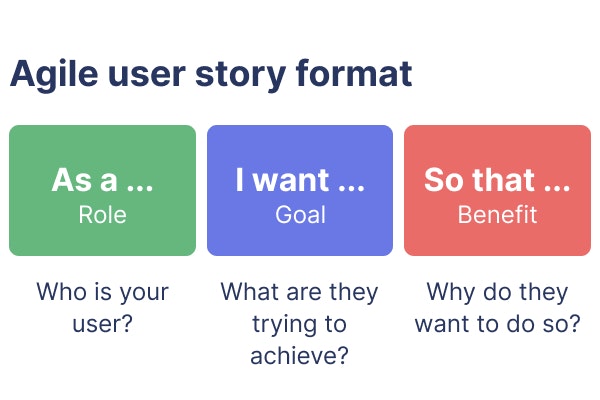
Best Practices for Writing User Stories
Prioritize User Perspective: A key component of user stories is understanding their perspective as users. Gather empathy from real users via interviews, surveys, or usability testing to ensure relevant and valuable stories.
Collaboration Is Key: Writing effective user stories requires a team effort from product owners, UX designers, developers and other stakeholders. Doing this ensures that stories cover multiple perspectives resulting in more robust and actionable user stories.
Simplicity and Clarity: User stories must be clear and easy to comprehend, free from technical jargon. A straightforward story will likely be implemented more accurately and promptly, reducing risks such as misinterpretations.
Validation Criteria: Validation criteria (also referred to as acceptance criteria) provide the criteria that must be fulfilled for a user story to be considered completed, helping ensure its implementation meets user needs and expectations. They provide an objective way of testing and validating features.
For example, a user story might be: "As a user, I want to reset my password so that I can regain access to my account." The validation criteria for this story could include:
The user receives an email with a password reset link.
The password reset link is valid for 24 hours.
The user can successfully create a new password using the reset link.
By implementing these best practices, teams can more effectively create user stories that meet user needs while aligning with team processes for product development. This approach will result in more user-centric product development processes.
Advanced Techniques for User Stories
Formulas and Frameworks
The 3 C's: Card, Conversation, Confirmation
Understanding and applying the 3 C’s framework can significantly enhance the effectiveness of your user stories:
Card: The card represents a physical or digital note that briefly describes the user's story. It’s a placeholder for future discussions and details.
Conversation: This involves detailed discussions between team members and stakeholders about the user story. These conversations help clarify the requirements and expectations, ensuring everyone understands the goal.
Confirmation: This includes the acceptance criteria that must be met for the story to be considered complete. It ensures that the implemented feature meets the user’s needs.
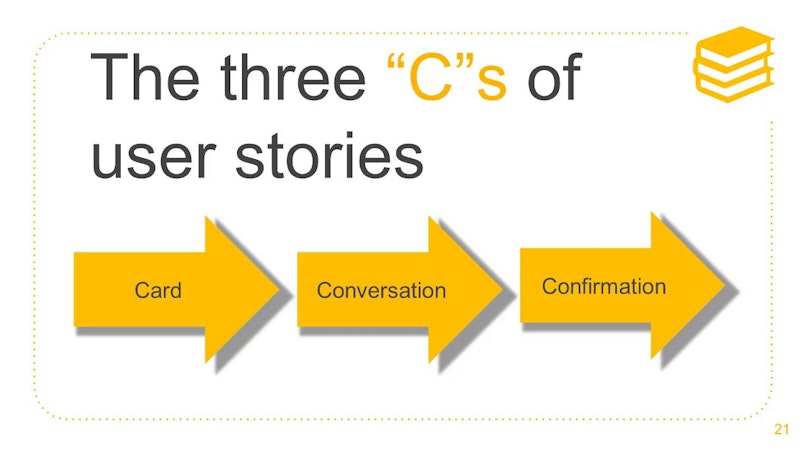
INVEST Criteria:
The INVEST acronym provides a checklist to ensure user stories are well-structured and effective:
Independent: Each story should be self-contained, without dependencies on other stories, allowing for flexible implementation and prioritization.
Negotiable: Stories should be negotiable, meaning the details can be discussed and refined as needed. They are not contracts but invitations for conversation.
Valuable: Every user story should deliver value to the user or customer, ensuring that development efforts contribute to the overall goals of the project.
Estimable: Stories should be estimable so that the team can gauge the effort required to complete them. This helps in planning and resource allocation.
Small: Keeping stories small and manageable ensures they can be completed within a single iteration or sprint, maintaining momentum and delivering continuous value.
Testable: Each story should have clear acceptance criteria to verify that the functionality works as intended, ensuring quality and user satisfaction.
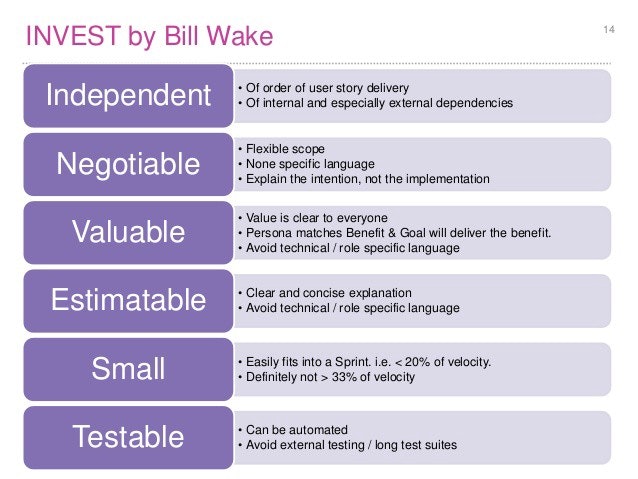
Common Pitfalls of Creating User Stories and How to Avoid Them
Vague User Stories: Avoid writing vague user stories that lack clear actions and outcomes. For instance, "As a user, I want a better interface" is too ambiguous. Instead, be specific: "As a user, I want a cleaner dashboard layout so that I can find key metrics easily."
Overcomplicating User Needs: User stories should be straightforward and focused. Overcomplicating them can lead to confusion and misinterpretation. Stick to the essential elements that define the user’s need and desired outcome.
Ignoring User Feedback: User stories should be informed by actual user feedback. Ignoring this crucial input can result in features that do not address real user needs. Regularly engage with users to gather insights and validate your assumptions.
By adopting these advanced techniques, teams can create user stories that are not only effective and actionable but also flexible and aligned with user needs. This structured approach leads to better project outcomes and more satisfied users.
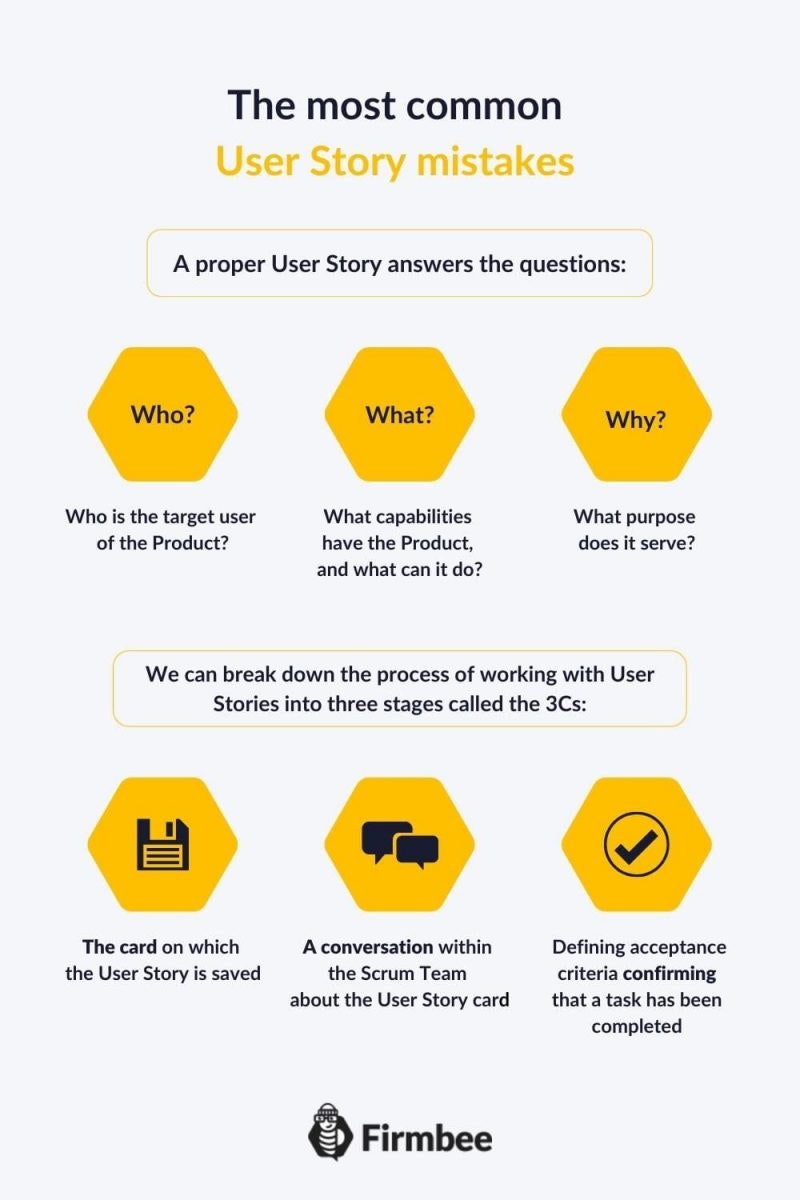
Examples of User Stories
Effective User Story Examples
Understanding the difference between poorly and effectively written user stories is essential for maintaining user-centricity and effectiveness during development processes. Here are some examples to illustrate these differences:
Here are a few examples:
❌ Poor example 1:
As an Instagram user, I want to share images, videos, and stories so that I can keep in touch with my friends.
✅Better example 1:
As a socially active person, I want to be able to share pictures of my life so I can update and stay in touch with my friends on life events.
❌ A poor example 2:
As a website visitor, I want to see buttons react on hover, so I can see that they’re clickable or inactive.
✅ A better example 2:
As a website visitor, I want to be able to find the listing I need quickly so that I don’t have to waste time browsing.
❌ A poor example 3:
As a project manager, I want to be able to track an employee’s progress, so I can do my job better.
✅ A better example 3:
As a project manager, I want to keep an eye on my teammates’ progress, so I can report on their work and offer help if necessary.
❌ A poor example 4: "I am looking for a button."
✅ A better example 4: "As a user, I require a submit button on the feedback form so I can submit my comments easily."
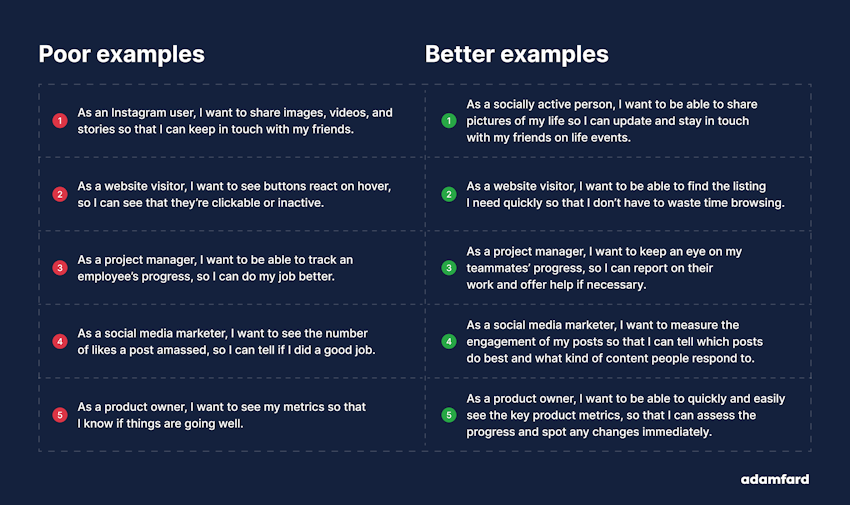
Specific Scenarios for Different Roles
Different roles within a system each have unique needs and objectives, so creating user stories tailored specifically for these roles ensures that all aspects of the product are user-friendly and functional.
User: "As a user, I would like to reset my password so I can regain access to my account if I ever forget my current one.
This story addresses a common need among users who have forgotten their passwords: to ensure they can regain access.
Administrator: "As an admin, I need access to user activity logs so I can monitor and address any suspicious or unlawful activity."
This story highlights an administrator's responsibility in maintaining security and overseeing system usage to effectively fulfil their role.
User Stories Case Studies
Real-world examples provide invaluable insight into how user stories are implemented across multiple environments. Here are some case studies from our portfolio:
KeyVeve: Product Design for a Debt Management Mobile App in the Fintech Industry. We developed user stories that focused on the needs of users managing their debts, ensuring the app was intuitive and effective.
Th!nkpricing: B2B SaaS AI Platform in Pricing Analytics. Our user stories helped streamline the AI integration, focusing on the users' need for accurate and actionable pricing data.
Ciphy: Communications Platform as a Service in the Communication Industry. User stories were essential in creating features that enhanced user communication and interaction.
By examining these case studies, you can see the practical application of user stories in various industries, demonstrating their versatility and importance in product development.
Integrating User Stories into Your Workflow
User Stories in Agile Methodology
User stories are a cornerstone of agile methodologies, providing a clear and user-focused way to capture requirements. They fit seamlessly into various agile frameworks such as Scrum and Kanban, enhancing both the planning and execution phases.
How User Stories Fit into Sprints and Backlogs
In Scrum, user stories are added to the product backlog, where they are prioritized based on business value and user needs. During sprint planning, the team selects a set of user stories to work on during the upcoming sprint. Each story is broken down into smaller tasks, making it manageable and actionable.
Kanban teams use user stories to visualize work, manage flow, and limit work in progress. Stories move through stages such as "To Do," "In Progress," and "Done," ensuring a continuous flow of work and immediate visibility into the status of each story.
Role of User Stories in Continuous Improvement
User stories support continuous improvement by facilitating regular feedback and iteration. After each sprint or release, the team reviews the completed stories, gathers user feedback, and identifies areas for improvement. This iterative process ensures that the product evolves based on real user needs and experiences.
Tools and Software for Managing User Stories
Several tools and software can help manage user stories effectively, ensuring they are tracked, prioritized, and completed efficiently.
Popular User Stories Tools (e.g., JIRA, Trello, Asana)
JIRA: A powerful tool for managing agile projects, JIRA offers robust features for creating, prioritizing, and tracking user stories. Its integration with other development tools makes it a favourite among agile teams.
Asana: This tool combines task management with team collaboration features, making it easy to create user stories, assign tasks, and track progress.
Trello: Known for its simplicity and visual approach, Trello uses boards, lists, and cards to manage user stories. It’s an excellent tool for smaller teams or those new to agile methodologies.
By integrating these tools into your workflow, you can manage user stories more effectively, ensuring they drive the development process and deliver real value to users.
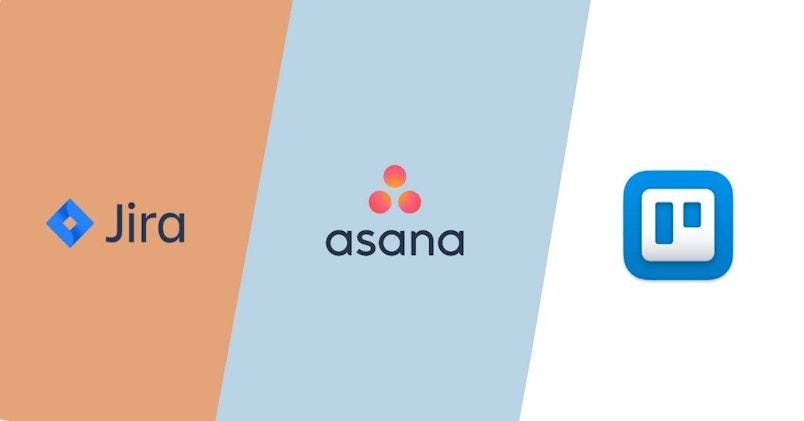
Enhancing Your User Stories with Research
User Research Techniques
Incorporating user research techniques into your user stories can significantly enhance their relevance and impact. Here are some effective methods:
Surveys: Conducting surveys helps gather quantitative data about user preferences, behaviours, and pain points. Use this data to inform and validate your user stories.
Interviews: One-on-one interviews provide deep insights into user experiences and motivations. These qualitative insights can uncover nuances that surveys might miss.
Usability Testing: Observing users as they interact with your product can reveal usability issues and areas for improvement. This direct feedback is invaluable for crafting precise and effective user stories.
Regularly applying these techniques ensures that your user stories are grounded in actual user needs and experiences, leading to more user-centric product development.
Persona Development
Creating detailed user personas is another powerful way to enhance your user stories. Personas are fictional characters that represent your target users. They include details such as demographics, goals, challenges, and behaviours.
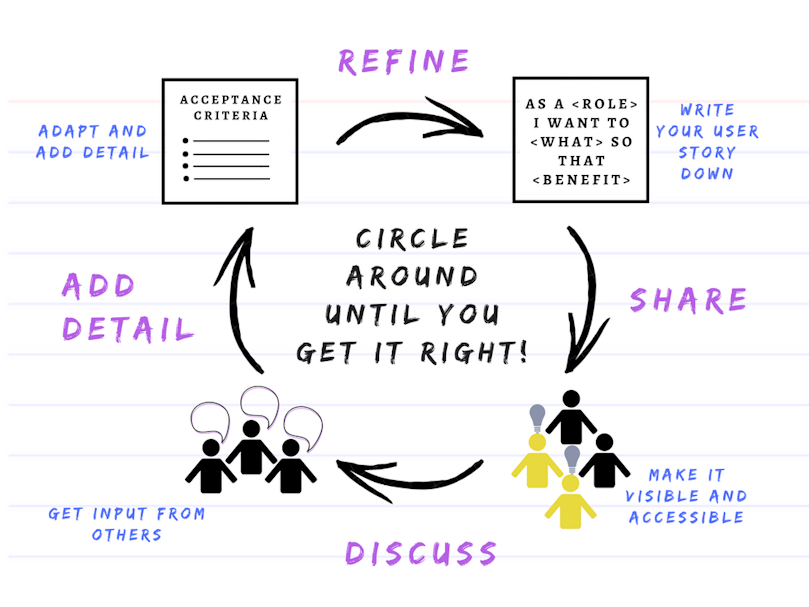
Steps to Create Effective Personas:
Conduct User Research: Gather data through surveys, interviews, and usability testing.
Identify Patterns: Look for common characteristics and behaviours among your users.
Create Personas: Develop profiles for each persona, including their goals, frustrations, and motivations.
Use Personas in User Stories: Refer to these personas when writing user stories to ensure they address specific user needs.
For example, if you have a persona named "Tech-Savvy Tim," a user story might be: "As Tech-Savvy Tim, I want to customize my dashboard layout so that I can quickly access the tools I use most frequently."
By using personas, you ensure that your user stories are not generic but tailored to the specific needs and characteristics of your target users.
Real-World Applications
User research and personas have been instrumental in many of our projects at Adam Fard UX . For instance, in our KeyVeve project, user personas helped us design a debt management app that truly met the needs of its users.
Similarly, for Th!nkpricing, user research informed the development of features that addressed key pain points in pricing analytics. By consistently integrating user research and personas into your workflow, you can create user stories that lead to more effective, user-centred products.
Conclusion
Recap of Key Points
User stories are essential for a user-centred approach in product development. They help prevent feature creep, facilitate team collaboration, and ensure that each feature adds real value. Effective user stories focus on the user's perspective, are collaboratively created, simple, clear, and have clear validation criteria. Advanced techniques like the 3 C's and INVEST criteria enhance their effectiveness.
While we've covered the essentials of building UX design for SaaS startups, many SaaS products fail not due to flawed ideas but due to choosing the wrong UX design partner. Selecting the right UX design agency is crucial for transforming your SaaS product into a user-friendly, market-leading solution. At Adam Fard, our comprehensive approach, commitment to innovation, and proven track record make us the perfect partner for your project.
Explore our past UX projects to see the successful designs we've created for delighted clients. Schedule a FREE consultation with our UX experts today to start crafting a satisfying user experience for your SaaS clients.





